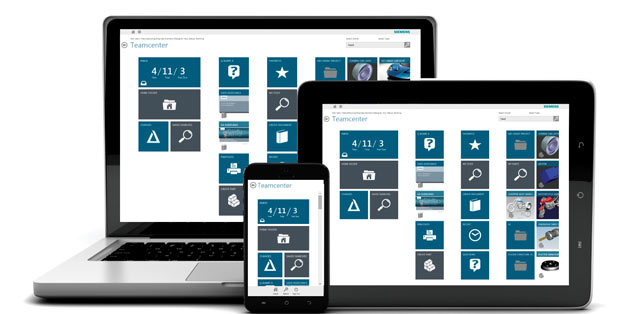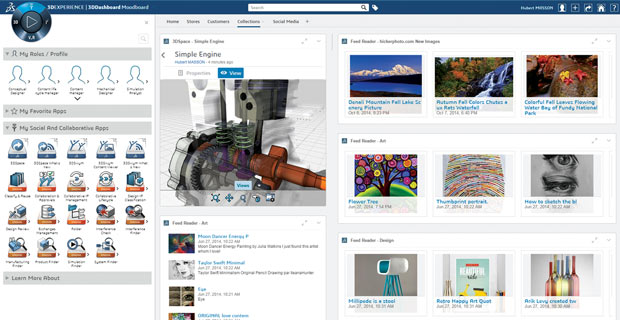
Active Workspace provides an identical user experience any time, anywhere, on any modern computing device without requiring your IT team to install and maintain device-specific applications. Image courtesy of Siemens PLM Software.
Latest News
December 1, 2015
 Active Workspace provides an identical user experience any time, anywhere, on any modern computing device without requiring your IT team to install and maintain device-specific applications. Image courtesy of Siemens PLM Software.
Active Workspace provides an identical user experience any time, anywhere, on any modern computing device without requiring your IT team to install and maintain device-specific applications. Image courtesy of Siemens PLM Software.Consumers want to be able to access whatever they’d like to at their fingertips—from restaurant recommendations to the weather. While engineers are creating products that help provide an “all-in-one” experience to consumers, they’re also realizing that product complexity is requiring them to find platforms that can manage multiple workflows and different data sets to collaborate across an entire enterprise. To aid this, companies are developing centralized ecosystems that can integrate CAD, CAE and PLM (product lifecycle management) capabilities within one space. Yet there’s concern that trying to connect data sets and files that aren’t necessarily interoperable could either mean long implementation times or closed ecosystems.
To address these concerns, companies are creating platforms that can give end users and industry customers the ability to address multiple stages of the product lifecycle while also being able to interpret each stage individually—all while adding features to improve the user experience and ease collaboration among departments.
“What matters to buyers is that the solutions they rely on most work well together,” says Monica Schnitger, president of Schnitger Corporation, a market analysis firm that specializes in engineering software. “For some, that’s CAD and CAE; for others, it’s the different flavors of CAD throughout their supply chains; for many, it’s managing significant amounts of data from varying sources and controlling the work processes that create that data. Because these needs change over time, as businesses evolve, these platforms must be open and able to accommodate new solutions, data types, business models and partnerships.” To make this possible, companies are charged with making engineering environments that are large enough to offer end-to-end engineering while also providing scalability.
Dealing with Data
Despite what functions engineering teams decide to use within an immersive platform, it’s imperative that data is presented in a way that can be used throughout multiple points in the design process and beyond to the large enterprise.
“One of the main things that users and customers are looking for is a way to streamline the way that people are getting to data,” says Bill Lewis, marketing manager for Teamcenter at Siemens PLM Software. “If you consider the implications of having an environment where it’s a single source that includes multiple components, you’re talking about a lot of data and a lot of different types of people interacting with that data.” This makes it important for software companies to figure out ways to help multiple users connect with the right context and people for the data that they work with, he says.
At Dassault Systèmes, the company’s 3DEXPERIENCE platform supports outside file formats to make data integration easier. “Studies have shown that engineers spend up to 40% of their time engaged in non-value added activities (looking for information, check-in/check-out, duplicating design information, etc.). The data-driven infrastructure of the 3DEXPERIENCE platform enables engineers to focus on innovation rather than administrative tasks,” says Andy Kalambi, CEO of ENOVIA at Dassault Systèmes. Because the environment is centered around design data, Kalambi notes that users can share CAD data with each other “irrespective of the original CAD authoring system, so that information can not only be stored and accessed, but [also] leveraged in the context of a virtual prototype.”
By bringing data to the center of the platform’s infrastructure, and increasing interoperability with outside applications, software companies are easing the need for data translation and helping multiple departments collaborate on a project. It also gives a stronger correlation of raw data and project management capabilities—letting users see the entire scale of a project.
“[With 3DEXPERIENCE], project management becomes data-driven by being linked with the product portfolio,” Kalambi says. “When the two processes are disconnected with different technologies, there are multiple projects being defined and tracked, but they are not grounded in the reality of the product data that is being created as part of the project. Now, suppose a single technology is used to permanently associate the definition and development of the product portfolio with the tracking of the projects used to govern it? The implications of portfolio decisions can be quickly assessed against project schedule. As a result, a project manager is taking action to resolve issues with a full understanding of the impact on the product portfolio.”
Bringing Work on the Go
In an age of social media and cloud capabilities, engineers are seeing more technology to help them gain ubiquitous access to their models and data. Mobility is becoming more apparent through Web-based software access and even smartphone and tablet applications. At this year’s Autodesk Accelerate event, presenters discussed what technology would enable engineers to address product complexity across multiple, worldwide teams. “Innovation and globalization are major drivers for business and complexity. We need a new set of tools and what’s really enabling it is the IT,” says Marc Halpern, research vice president at Gartner Research, an IT research company. “The four major trends that are driving product innovation platforms are mobility, social networking, Big Data and the cloud.”
 Dassault Systèmes’ 3DEXPERIENCE environment has a data-centered infrastructure and role-based profiles to help users access specific projects and customize their own dashboard. Image courtesy of Dassault Systèmes.
Dassault Systèmes’ 3DEXPERIENCE environment has a data-centered infrastructure and role-based profiles to help users access specific projects and customize their own dashboard. Image courtesy of Dassault Systèmes.To bring design and simulation into an infrastructure where engineers can access their data at any time, more companies are creating specific applications and Web-based portals. Dassault Systèmes offers its own 3DPlay app, where engineers can manipulate product data and check simulation results. At Siemens PLM, the company’s Active Workspace enables PLM management from a Web-browser. By offering engineering software in mediums that are similar to what designers use as consumers, it can remove some of the technical overhead. “With Active Workspace, we’re trying to take lessons on how users are interacting and working with the online world in their day-to-day life [and apply that to PLM],” says Lewis.
Filling in the Gaps with Partnership
With these environments offering multiple roles and personas for engineers to access data, how are companies able to create a program that is simultaneously both general and specific? Corporate collaboration is one answer because it helps to increase interoperability among different platforms via integrations and plug-ins.
“I don’t think anybody has deployed an all-in-one kind of solution, and there are going to be requirements to leverage what the customer already has. While we offer a broad footprint, we also have to have the ability to work with other tools and other systems,” says Lewis. Having this compatibility with other software has also led Siemens PLM Software to grow its partnership programs to help provide toolsets for all the use cases Teamcenter supports. “[When creating a platform like Teamcenter, we ask:] ‘What are people already deploying and how can you fit into those systems that they already have?’” says Lewis.
Lewis’ sentiment isn’t uncommon. Partnerships to help create a more encompassing design environment are appearing elsewhere in the industry. For example, Autodesk, National Instruments and the University of California, Berkeley have launched a partnership to help connect and streamline the tool supply chain. The goal of this collaboration, is to “take the output of Autodesk Inventor, put it together with Modelica [an object-oriented system modeling language], and feed it into the simulation and control design module in [NI’s] LabVIEW,” according to Dave Wilson, academic marketing director at National Instruments. (For more, see “Autodesk, NI, and UC Berkeley to Jointly Develop Control System Design Workflow”).
Cause for Concern?
While a more complete design environment can offer a central access point for multiple project stages, companies also need to address concerns of scalability, interoperability and long implementation times. As a solution, environments will often have a certain amount of customization available to add-on to the main infrastructure.
“The modular architecture of the 3DEXPERIENCE platform provides the flexibility to enjoy the collaborative benefits of the base solution and add role-based apps, as needed. The available apps span design, simulation, manufacturing and more, and are available tailored for specific industry challenges,” says Kalambi. He also notes that to help more industries, the company has expanded its base beyond manufacturing to newer sectors such as life sciences and packaged goods.
Lewis says that Teamcenter has developed Rapid Start, a preconfigured solution that includes some common industry best practices and features for PLM. By providing an out-of-the-box foundation, customers can start using the software’s capabilities more quickly and then decide if it needs to be expanded or customized.
However, even with larger end-to-end engineering environments, it’s rare that a company decides on a complete switch to a new platform. “It’s usually a more organic process, where a division or product line selects a new tool because it has capabilities that the legacy solution doesn’t provide, and proves out that this approach works—only then is the new platform rolled out on a wider basis. Today, the platforms more often need to mold to the enterprise’s needs. Today’s incremental approach is faster, less disruptive and can build success a bit at a time,” Schnitger says.
Despite the idea of the design platform becoming more apparent in industry, engineering teams still need to have software that is scalable and accessible. By creating platforms that offer customization beyond a main infrastructure, mobile and Web portals, and the ability to integrate outside niche software, companies are setting a new standard for collaborative engineering.
More Info:
Subscribe to our FREE magazine, FREE email newsletters or both!
Latest News
About the Author
Jess Lulka is a former associate editor for Digital Engineering. Contact her via [email protected].
Follow DE





